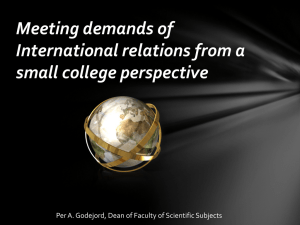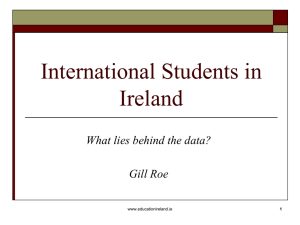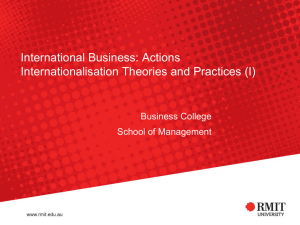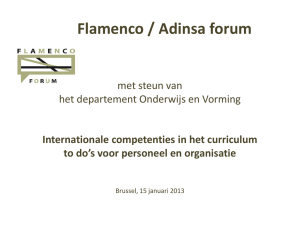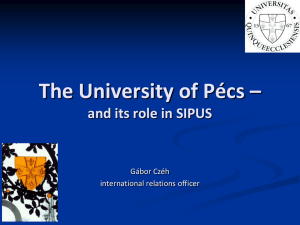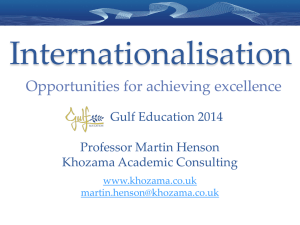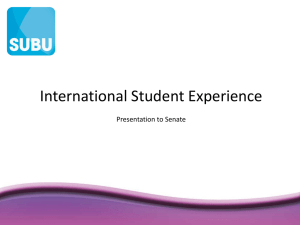Internationalisation in higher education
advertisement
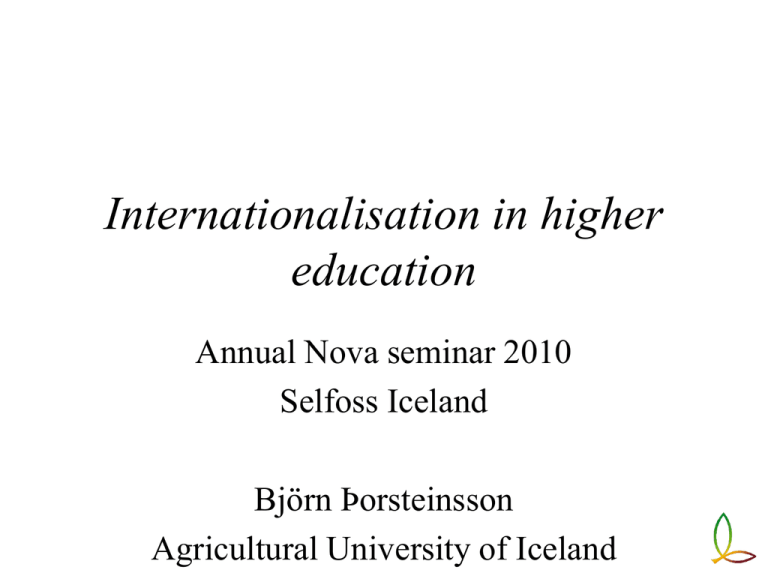
Internationalisation in higher education Annual Nova seminar 2010 Selfoss Iceland Björn Þorsteinsson Agricultural University of Iceland • Most of the research available on acedemic mobility and international education seems to be occational, coincidental, sporadic and episodic. • Ulrich Techler 1996 Authors adressing the international dimensions of higher education • • • • • Philip G Altbach Marvin Bartell Jane Knight Barbara Kehm Ulrich Teichler • • • • • Hans de Wit Peter Scott Ivar Bleiklie Ase Gronitzka Marijk van der Wende • Medival universities were international institutions • Nation-state focused academie inward • After emergence of third world from colonialism in mid 20th century, national universities were established • Now academie has regained international scope and direction • Many forces propel internationalization • Altbach and Knight 2007. Globalisation • Globalisation is the flow of technology, economy, knowledge, people, values, ideas..... across borders. • Globalisation affects each country in a different way due to nations individual history, traditions, culture and priorities • Knight 1996 Internationalisation • Internationalisation of higher education is one of the ways a country responds to the impact of globalisation yet, at the same time respects the individuality of the nation. • Thus globalisation can be seen as the catalyst but internationalisation as a response • Knight 1996 Four approaches to internationalization Knight (1996) : – – – – Activity Competency Ethos Process Activity: • Types of activity to describe internationalization: – – – – Curriculum, student / faculty exchange, technical assistance, international students. Competency: • Development of new skills, knowledge, attitudes and values by students, faculty and staff. • As the emphasis of outcomes of education grows there is increasing interest in identifying and defining global/international competencies. Ethos • Emphasis is on creation a culture or climate on campus, which promotes and supports international/intercultural activities or initiatives Process: • Integration or infusion of an international or intercultural dimension into teaching, research and service through a combination of a wide range of activities, policies and procedures • Marvin Bartell (2003) claims that Internationalisation may be viewed as occurring on a continuum. ....... • Bartell M, 2003 Internationalization of universities: A university culture-based framework. Higher education 45:43-70 • ... At one end we can have limited, symbolic internationalisation reflected by handful of students from distant countries having presence on a campus.... • .... while at the other end internationalisation is a synergistc transformative process, involving curriculum, research programs, that influences the role and and activities of all stakeholders, including faculty, students, administrators and community-at-large.... • Universities are complex organisations with distinctive set of characteristics which have strong impact on culture of those intitutions. • In summary: universities are loosely coupled systems or more colorfully expressed organized anarchies. • What can be measured: • • • • • • • • 1) International student participation 2) Curriculum change 3) International partnerships 4) Mobilizing financial, human and technological resoruces for internantionalisation 5) University private partnerships 6) Faculty contribution to internationalisation 7) Contribution of research to internationalisation 8) Contribution of university internationalisation development projects to internationalisation • Canadian indicators granting awards for excellence in Internationalisation (asssociation of Universities and Colleges of Canada and the Bank of Nova Scotia) Research topics in international education (Kehm and Teichler 2007) • Kehm and Teichler 2007. Research on Internationalisation in Higher Education. Journal of Studies in international Education vol 11 No 3/4 Major themes in research litearture • Mobility of students and academic staff • Mutual influences of higher education systems to each other • Internationalisation of the substance of teaching learning and research • Institutional strategies of internationalisation • Knowledge transfer • Cooperation and competititon • National and supranational policies as regarding the international dimension of higher education Mobility of academic staff and students • Mobility flows and • Support structures for statistics, international students • Impact of mobility on • Organization and careers, funding of study • Recognition of study abroad, abroad, • “Virtual mobility” • Vertical and horizontal with the help of ICT mobility, • Recruitment and selection of international students Mutual influences of higher education systems on each other • Influenced by globalization and trade in educational services • Strategic alliances • Export of study programs • Branch campuses abroad • Convergence of the European higher education systems • Developed and developing countries. Internationalisation of the substance of teaching, learning, and research • Definition to analyses of practice • Internationalization of curricula • Quality of international programmes • Internationalisation at home • The role of foreign language knowledge and teaching and learning in a foreign language • Joint and double degree programmes Institutional strategies of internationalisation • Marketing, • Profile building, • Active and selective recruitment of foreign students, • Export of programs • Partners for exchange • Education as business • Rankings and quality issues Knowledge transfer • Underlying rationale in debates about the role of the university in the knowledge society. • This special topic will be discussed by Professor Jón Torfi Jónasson later this morning. Cooperation and competition • Higher education system made more attractive to foreign staff and students • Higher education institutions more selective in their choice of partners • A shift from cooperation to competition • Competitiveness usually accompanied by strategic alliances • Brain drain, brain gain, and marketisation of higher education National and supranational policies • national policies continue to play an important role • policies of international and supranational organisations • higher education institutions in developing and developed countries • European cooperation and integration processes • European Commission • GATS • World Bank • UNESCO • OECD • Nordic Council of Ministers Major conclusions (Kehm and Teichler 2007) • Mobility is no longer that of students and staff alone but also of programmes. • Driving forces are no longer institutions and national policy makers alone but increasingly also supranational organisations. • New actors have entered the field- international consortia and networks. • higher education has shifted to encompass all regions of the world. The future of internationalisation • International students 2 million in 2007 • How many in 2025? Uncertainities in future internationalization • • • • • • • • • Political realities and national security Government policies and the cost of study Expanded domestic capacity English The internationalization of the curriculum E-learning The private sector Quality assurance and control European policies • Altbach and Knight 2007 Conclusions • International higher education will provide substantial access in some countries and will be a “niche market” in others. • Today’s emerging programs and practices must ensure that international efforts in higher education as the NOVA network benefits the public and strengthens our universities.
